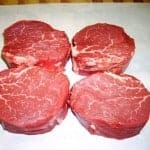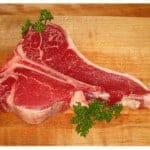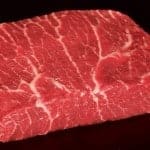

It is a warm spring evening and you are barefoot on a freshly cut lawn. In front of you is dinner: a beautifully cooked Perfect Steak, so juicy that it is running right into your potatoes. The spices and smoke from the BBQ tease your tastebuds in an almost carnal fashion. You pick up your knife, and it slides through the steak with ease, showing the bright pink within. This description may seem borderline inappropriate, but this is the type of experience we expect from our steak dinners, if only because of the costs involved. Would you spend $500 on a BBQ just to cook burgers? Too often, the next scene of this story is a frustratingly long chew, the ultimate letdown. A few little tricks, combined with some experience, can vastly improve your ability at choosing and cooking the perfect steak.
The first question should be what type of steak do you want to eat? We are all aware of the steak lore: the illustrious T-Bone, the good value Sirloin, the tender Tenderloin. It’s almost like choosing what brand of car you prefer, based more on style and image preferences than actual test drives. But what are the real differences we can expect from the most common cuts of beef?


Sirloin –
A good value steak because of its slightly lower quality combined with the large number of sirloin steaks that can be cut from the cow. There is much variability from sirloin to sirloin, inevitably leading to inconsistency in the quality of the final product. The steak pictured at right is a cross-section of the whole sirloin roast, and would typically be cut into 3-5 individual steaks. Sirloins tend to be a leaner steak, and usually have a rich ‘beefy’ flavor. Because of its leanness, the sirloin is usually best at medium or medium-well to heat the meat all the way through. A good steak for marinating.


New York Striploin
Perhaps the most typical of all steaks, meaning that it has a good mix of rich flavor, tenderness, consistency, and a fair price. The most recognizable aspect of the New York is the fat cap along the top side of the steak, which is crucial to help keep the steak moist as it cooks. The striploin’s weakness is its preponderance to dry out on the grill; mostly this is because it is often cut too thin and then overcooks quickly. As a rough rule try for at least 1 inch thick. Striploin are best at medium or less to lock in the juiciness before it has a chance to dry out. The best steak to stand up to your best wines.


Filet Tenderloin
True to its name, this is the most tender, and for many the pinnacle, of all steaks. At its best, the Filet does not even need a knife to be cut and melt in your mouth. These steaks are so soft that if over-aged they will fall right apart on the grill. Cooking them requires a trained grill man or at least a stopwatch since a medium-well tenderloin feels the same as a medium-rare one when pressed down on. However, anything less than well seems to produce a good result with these fantastic steaks. The weakness of Filet is its relative lack of flavor and its high price. Wrapping the steak in bacon or providing a sauce to dip in can help with the flavor. Filet can be worth up to twice as much as New York, or four times as much as Sirloin. The steak you use to impress a guest.


T-Bone Porterhouse
A bit of a sheep in wolf’s clothing, the T-Bone is notoriously hard to cook properly and is most cases proof that adding two great steaks together is not better than each steak individually. The two steaks that are wedged together on one bone are the Filet and the New York, the Filet being the smaller side of the T-Bone. This creates a monster-sized steak, expensive to boot, and is usually cut way too thin as a result to get the weight and cost down to earth. As soon as these hit the grill, the real problems start. Going over medium-rare means you probably need to go right to well done because of the variation in cooking times between the two sides, as well as variations from the meat on the edge of the steak going towards the bone. A medium T-Bone will be red against the bone. However, for a real meat-head, a thick cut T-Bone (or the best T-Bone cut, the Porterhouse) cooked rare can be a great showcase of the best that beef can do.


Rib Steak
If you like your steak juicy, the heavy marbling of the rib steak or dry aged ribeye is the way to go. While rib steaks and rib eyes can appear quite different, featuring variations in the fat running through the steak or even a bone affixed to one side, the meat itself is really the same in character. It has a slightly sweet, gamey, earthy flavor, and so much marbling that some steaks cross the line and are just plain fatty. When cooking the steak much of the fat melts into the meat creating a situation where the steak is saturated in juice. Overcooking can eventually suck out the juice entirely leaving an insipid steak behind. However undercooking will leave an overly fatty steak that approaches unchewability. Stick with medium-rare.


Flat Iron Shoulder Steak
A bit of an odd duck, many butchers do not feature this steak in their portfolio but it can be exceptional when aged correctly. As you can see in the picture, the marbling is similar to the Rib Steak, and often this steak is best if it is sliced against the grain after being cooked to break up some of the fatty streaks in the meat. The flavor is a complex earth flavor, not as juicy as a rib steak but with the tenderness of a Filet. The texture is a bit rougher, similar to a sirloin. Because of its tenderness combined with rich marbling the steak is good from medium-rare right to medium-well, but not a pure rare or well.
Conclusion – Perfect Steak
In the coming weeks, we will examine the aging, marbling, marinating, and cooking of a perfect steak.



